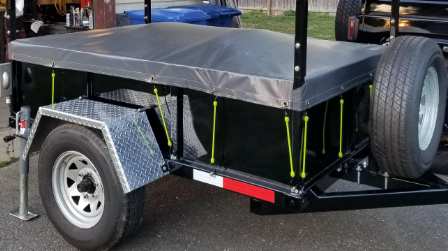 If you are looking for a new tarp to cover your utility trailer there are a number of things you need to consider before you place an order. Please review this article to make sure you get the size and material you need.
If you are looking for a new tarp to cover your utility trailer there are a number of things you need to consider before you place an order. Please review this article to make sure you get the size and material you need.
Generally speaking, utility trailer tarps are purchased for two main reasons:
Another decision you will need to make is whether to order a simple rectangular tarp or a fitted tarp shaped like a box top. Fitted tarps provide a cleaner look since the corners are sewn and you don't have to tuck in the excess material that normally forms in the corners of a flat tarp. Fitted tarps are more expensive since they require more sewing. There is also something in between fitted and flat where we cut out the corners but don't sew the corners together. Instead we make a flap that can be tied closed using grommets.
If you are ordering a fitted or flapped tarp it is important to ensure the size is very accurate. In the order screen you need to specify the size if the "box top" as well as the distance to go down the sides. The box top should be about one inch larger (in both directions) than the size of the trailer top. This gives us a bit of tolerance since if it too tight it won't slip on and off.
Sizing flat tarps is a little easier. For these you need to decide how far you want the tarp to come down the sides, then you add twice this distance to the width and length of the trailer to get the tarp size. For example, if the top of your trailer is 4' x 7' and you want it to come down the side of the trailer by one foot you would order a tarp that is 6' x 9'.
When measuring how far down the sides of the trailer you want the tarp to go there are a few things you should consider:
Grommets are the eyelets we add to the side of the tarp to allow you to secure it. You will want to specify sufficient grommets to allow you to secure the tarp tightly. You want to avoid having the tarp flap in the wind while travelling since this "wind whip" can cause the tarp to age rapidly. At the same time you don't want so many fasteners that if becomes too time consuming to fasten the tarp. Also, there is no point in having a lot of grommets if you don't have places on the trailer to attach them to. In most cases, having a grommet every two feet of so is sufficient.
You will also need to choose a colour for your tarp. The colour you choose will often depend on whether you want to tarp to be somewhat camouflaged or discreet vs. bright and conspicuous. Also dark colours will tend to get hotter than light colours.
Follow this link to learn more about ordering a utility trailer tarp. If you are not sure about anything we describe here give us a call before you place your order and we will try to give you the best advice.